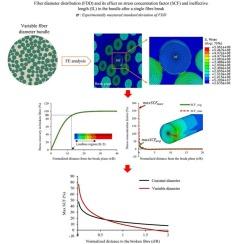The effect of variable fiber diameters in unidirectional fiber-reinforced bundles on stress redistributions around fiber breaks
IF 3.8
3区 工程技术
Q1 MECHANICS
International Journal of Solids and Structures
Pub Date : 2025-10-04
DOI:10.1016/j.ijsolstr.2025.113687
引用次数: 0
Abstract
Finite element modeling is conducted to simulate the stress redistribution around a broken fiber (BF) in a bundle with experimentally measured fiber diameter distributions (FDD), followed by a parametric study of the influence of the FDD coefficient of variation on the stress concentration factor (SCF) and ineffective length (IL). Two variants of the SCF definition are considered: based on average, SCFavg, and maximum, SCFmax, stress in the fiber cross-section. Results demonstrate that bigger fiber diameters show higher SCF and clustering of such fibers increases SCF in nearest neighbor fibers (NNFs). Critically, maximum stress-based SCF () significantly exceeds average stress-based SCF (), with differences about 40–75% in NNFs for FDD bundles compared to fiber constant diameter (FCD) bundles. This emphasises the necessity of prioritizing maximum stress criteria over conventional average stress models in failure predictions. The findings challenge benchmark models that rely on averaged SCF values, offering critical insights for improving accuracy in predicting fiber break propagation and composite strength.

单向纤维增强束中变径纤维对纤维断裂周围应力重分布的影响
利用实验测量的纤维直径分布(FDD)进行了有限元模拟,模拟了束中断裂纤维(BF)周围的应力分布,并对FDD变异系数对应力集中系数(SCF)和失效长度(IL)的影响进行了参数化研究。考虑了SCF定义的两种变体:基于纤维截面上的平均应力(SCFavg)和最大应力(SCFmax)。结果表明,纤维直径越大,SCF越高,纤维的聚集增加了近邻纤维(NNFs)的SCF。关键的是,最大应力基SCF (maxSCFmax)显著超过平均应力基SCF (maxSCFavg),与纤维恒径(FCD)束相比,FDD束的nnf差异约为40-75%。这强调了在失效预测中优先考虑最大应力准则而不是常规平均应力模型的必要性。研究结果挑战了依赖平均SCF值的基准模型,为提高预测纤维断裂传播和复合材料强度的准确性提供了重要见解。
本文章由计算机程序翻译,如有差异,请以英文原文为准。
求助全文
约1分钟内获得全文
求助全文
来源期刊
CiteScore
6.70
自引率
8.30%
发文量
405
审稿时长
70 days
期刊介绍:
The International Journal of Solids and Structures has as its objective the publication and dissemination of original research in Mechanics of Solids and Structures as a field of Applied Science and Engineering. It fosters thus the exchange of ideas among workers in different parts of the world and also among workers who emphasize different aspects of the foundations and applications of the field.
Standing as it does at the cross-roads of Materials Science, Life Sciences, Mathematics, Physics and Engineering Design, the Mechanics of Solids and Structures is experiencing considerable growth as a result of recent technological advances. The Journal, by providing an international medium of communication, is encouraging this growth and is encompassing all aspects of the field from the more classical problems of structural analysis to mechanics of solids continually interacting with other media and including fracture, flow, wave propagation, heat transfer, thermal effects in solids, optimum design methods, model analysis, structural topology and numerical techniques. Interest extends to both inorganic and organic solids and structures.

 求助内容:
求助内容: 应助结果提醒方式:
应助结果提醒方式:


